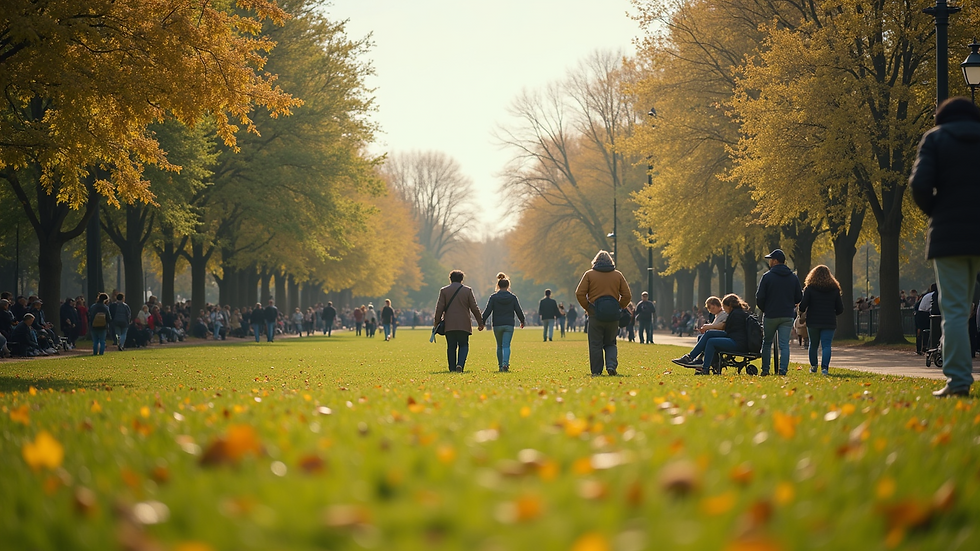Beyond Burnout: Building Everyday Habits for Sustainable Well-Being
- Dr Paul McCarthy

- Jul 14
- 4 min read
In today's fast-paced world, burnout has become an all-too-familiar term. Many of us find ourselves stretched thin, juggling work, family, and personal commitments. However, understanding burnout is only the first step. The real challenge lies in developing sustainable habits that help us maintain energy and foster well-being. This blog post will delve into practical daily routines, rest and recovery strategies, and tips for building a sustainable well-being lifestyle that goes beyond burnout.
Understanding Burnout and Its Effects
Burnout is not just a buzzword; it is a state of emotional, physical, and mental exhaustion caused by prolonged stress. A report from the World Health Organization states that burnout can lead to physical health issues, emotional distress, and negative impacts on productivity. Recognizing the signs of burnout early, such as fatigue, cynicism, or inability to focus, is crucial.
To combat burnout, focus on building a routine that emphasizes rest, recovery, and self-care. Sustainable well-being is about making small, manageable changes that accommodate your lifestyle rather than adopting unrealistic expectations.
The Importance of Daily Routines
Effective daily routines are the backbone of sustainable well-being. They provide structure to our day and minimize decision fatigue. Establishing a morning routine can set a positive tone that lasts throughout the day. Here are some suggestions for building an effective daily routine:
Morning Rituals: Start your day with low-energy activities, such as meditation or light stretching. This helps you awaken gradually and prepares your mind for the day ahead.
Scheduled Breaks: Incorporate scheduled breaks during work hours. A simple Pomodoro technique, where you work for 25 minutes and then take a 5-minute break, can improve focus and prevent fatigue.
Evening Wind-down: Create a relaxing evening routine to signal to your body that it is time to wind down. This could include reading, a warm bath, or practicing gratitude through journaling.

By sticking to these routines, you create a rhythm that fosters energy and reduces the chances of burnout.
Prioritizing Rest and Recovery
Rest is not just absence of activity; it is an active process that replenishes our energy. Many people mistakenly view rest as laziness, but it is essential for maintaining productivity. Here are some actionable strategies to prioritize rest and recovery:
Sleep Hygiene: Aim for 7-9 hours of quality sleep each night. Establish a sleep-friendly environment by keeping the room dark, cool, and quiet. Avoid screens an hour before bedtime to help your body produce melatonin.
Mindful Moments: Introduce short periods of mindfulness into your day. Even five minutes of mindful breathing can restore focus and calm your mind. Apps like Headspace or Calm can guide you through this process.
Active Recovery: Engage in low-impact activities such as yoga or walking, which can be restorative and promote mental clarity. Research suggests that light exercise helps release endorphins, combating feelings of stress and fatigue.

Incorporating these strategies into your daily routine will reinforce the importance of prioritizing rest and recovery.
Nutrition as a Key Component
Diet plays a significant role in our overall well-being and energy levels. Eating nutritious meals can help shield you from stress and burnout. Here are some tips on how to use nutrition to fuel well-being:
Balanced Meals: Focus on whole foods, including fruits, vegetables, whole grains, lean proteins, and healthy fats. Provide your body with the nutrients it needs to function optimally.
Hydration: Never underestimate the importance of staying hydrated. Dehydration can lead to fatigue and decreased cognitive function, making it easier to feel overwhelmed.
Mindful Eating: Practice mindfulness during meals by slowing down and savoring each bite. This not only enhances your enjoyment of food but can also help you recognize when you are full.
Making intentional choices about nutrition and hydration can have profound effects on your energy levels and mood.
The Role of Social Connections
Building and maintaining social connections can be a powerful antidote to burnout. Engaging with friends, family, or community groups offers emotional support and a sense of belonging. Here’s how to foster meaningful social connections:
Quality Over Quantity: Focus on building a few deep connections rather than trying to maintain a large social network. Invest time in relationships that uplift you and provide mutual support.
Set Boundaries: In our hyper-connected world, it’s essential to set boundaries with technology. Schedule time away from screens to engage in face-to-face interactions or outdoor activities.
Volunteer: Consider volunteering for a cause you are passionate about. Helping others fosters a sense of community and purpose, which can be incredibly rewarding and rejuvenating.

Taking the time to nurture social connections can create a strong support system that enhances well-being and reduces feelings of burnout.
Long-term Strategies for Sustainable Well-Being
Fostering sustainable well-being requires ongoing reflection and adjustment of your habits. Here are some long-term strategies to consider implementing:
Regular Check-ins: Schedule regular self-reflection sessions to assess how you feel physically and emotionally. This allows you to adjust your routines according to your current needs.
Self-Compassion: Practice self-compassion by acknowledging that it is okay to feel overwhelmed at times. Treat yourself with kindness and understanding during difficult moments.
Set Achievable Goals: Rather than striving for perfection, set achievable goals that motivate rather than overwhelm you. Celebrate small victories and progress.
By integrating these habits into your life, you build resilience against burnout and create a more balanced lifestyle.
Mindset Shift for Sustained Change
While implementing routines and strategies is important, embracing a mindset shift can make all the difference. Adopting a growth mindset encourages you to view challenges as opportunities for growth. This perspective allows for flexibility and adaptability in facing life’s hurdles.
Be mindful of negative self-talk and reframing it into positive affirmations. Cultivating a mindset of resilience, curiosity, and openness to learning aids in both personal development and well-being.
Sustainable well-being is a continuous journey. By focusing on daily habits, rest, nutrition, social connections, and mindset, you pave the way for a more fulfilling and balanced life.
By taking these small, actionable steps, you can not only avoid burnout but also cultivate a lifestyle that prioritizes well-being and energy. The key is consistency; make these practices part of your life rather than a temporary fix.
Your journey toward sustainable well-being is a personal one. Reflect on where you may need to make changes and embrace the process with patience. As you invest in yourself and your routines, you'll find that you can thrive beyond burnout and lead a more enriched, vibrant life.








